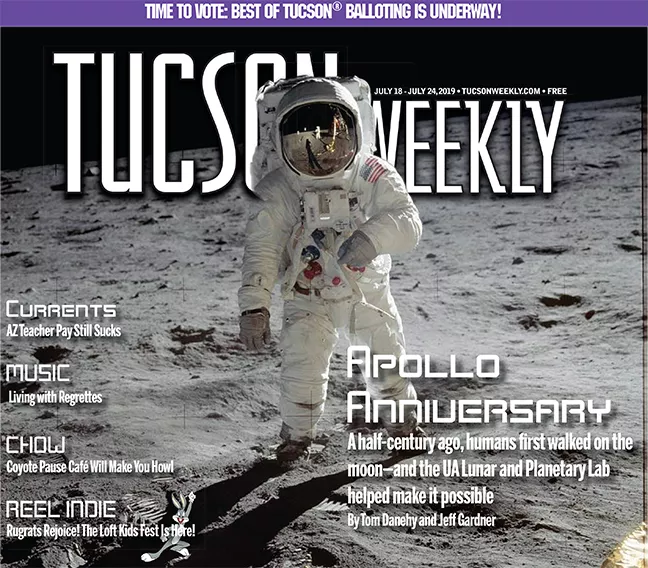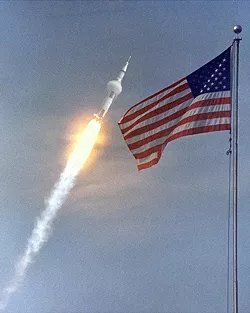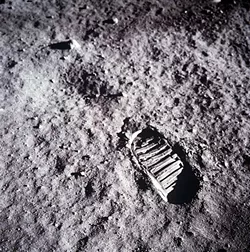Some of us Baby Boomers were blessed to have been just old enough to sort-of understand President Kennedy's words when he said that we (the United States and/or mankind) were going to the moon by the end of the 1960s. It energized us in a way that would shape our lives through an academic dedication to math and science and give us a glimmer of hope that faded during the race riots and the assassinations and even during the ghastly setbacks and gruesome deaths in the Space Program itself as that horrible and glorious decade trudged along, but it never went away. We followed the progress religiously from the Mercury to the Gemini and finally to the Apollo. We knew their names and their missions. We came to appreciate the logical progression that NASA was following—from sub-orbital to orbital flights; from one-man capsules to two-man missions, then finally to three-man crews heading to the moon.
And on that summer night, we turned on the TV and watched the grainy images, broadcast live from a quarter of a million miles away, of the single-most-amazing thing the human race had ever accomplished.
It was 50 years ago this week, and no, it doesn't feel like it was yesterday. It feels like it was 50 years ago. And it also feels like we should be way more scientifically advanced that we are. Technology has surged forward, but we, as a civilization, seem to have lost our fire. Back then, it was said that we had The Right Stuff. Nowadays, we just have stuff.
But oh, it was a magnificent time, one that should not be celebrated every 50 years, but every year as it showed us who we were and what we could be.
In retrospect, what was really impressive is the pace at which things had picked up. President Kennedy's words had hung over the Space Program for nearly a decade, acting as both a rallying cry and a loud, ticking clock. There had been setbacks, by far the worst of which was the death of Gus Grissom, Ed White and Roger Chaffee in a fire on the launchpad during a check of the capsule. Grissom, the second American to go into space, White, the first American to "walk" in space, and Chaffee were to be the crew for Apollo 1.
The first Apollo mission with a crew was Apollo 7 and it went into space in mid-October of 1968. A couple months later, Apollo 8 became the first manned mission to make it to the Moon. The crew was led by Frank Borman (who had played football at Tucson High with Morgan Maxwell and Karl Eller). Borman famously read from the Bible as the spacecraft orbited the moon on Christmas Eve.
Just a couple months later, Apollo 9 went into Earth orbit and tried out many of the systems that would keep the moon landing crew(s) alive and functioning. In May of 1969, Apollo 10 went to the moon and the Lunar Module was detached and flew down near the lunar surface.
To this day, I wonder if the two guys in the LM (Tom Stafford and Gene Cernan) had ever had the idea to declare some kind of fake emergency and land on the Moon, thereby being the first forever and ever.
There was a near-disaster when the LM made it back to the Command Module. A series of small pilot errors had set the LM off course and when they tried to dock, the LM went into a horrible spin. It took them four minutes to fix things, but the flight was deemed enough of a success that the decision was made that NASA would go for it all on July 20, 1969.
As the build-up to the lunar mission progressed, work vital to the moon landing's success was being done across many industries. Everything from freeze-dried food to smoke detectors to improved home insulation can be traced back to work done at NASA. Cordless tools use technology that was originally invented to help the astronauts drill for Moon samples. And scratch-resistant lenses were originally developed for the astronauts' helmet visors.
There was also the introduction of memory foam, Velcro, and shoe insoles that would be adapted by Nike and other athletic-shoe companies. Perhaps most significant of the new technologies was the development of micro-electronics and computing systems. Gordon Moore and Robert Noyce had been working for Fairchild Semiconductor, which had a contract to supply integrated circuits for the Apollo spacecraft.
The two men broke away in 1968 to form a new company which they called Intel. (They thought about using their own names, but Moore-Noyce sounded too much like "more noise," so they went another direction with it, using the portmanteau from Integrated Electronics.) Moore was already well-known for his formulation of Moore's Law, which states that the computing power of chips will double roughly every 18 months. The law has pretty much held up over the past half-century.
In the end, however, while Fairchild and Intel were starting the legend of Silicon Valley, NASA went mostly with chips from Philco in Philadelphia.
However, all those advancements would have gone for naught if NASA and the crew weren't able to get to the Moon, land safely and get Armstrong and Aldrin back to the command module to get home. The Moon is an inhospitable place for spacecraft attempting to touch down safely (more on that later) and it was entirely possible that the three-day trip at 24,000 miles per hour would be a piece of cake compared to finding the right landing spot.
Enter the Lunar and Planetary Laboratory at the University of Arizona. Founded in 1960 by legendary planetary scientist Gerard Kuiper, the LPL provided painstakingly-created lunar maps that helped NASA find the best landing spot for the Apollo 11.
Kuiper was quite a "get" for the University of Arizona. He had been a star (pun unavoidable) in his astronomical niche field of planetary science for quite some time before arriving in Tucson. Born in The Netherlands, Kuiper was the son of a tailor. Legend has it that he had extraordinary eyesight that allowed him to see stars that are four times fainter (magnitude 7.5) than the limits of those seen with people with normal eyesight. He attended Leiden University, which had been founded in 1575 by William, Prince of Orange, who led the Dutch Revolt (against Spain) in the Eighty Years' War. You'll love this: famous Leiden alumni include John Quincy Adams, Rembrandt, Enrico Fermi, and Paul Verhoeven, who directed the classic sci-fi social satire, the original RoboCop. (That movie, about a corporate-produced cyborg trying to maintain law and order in New Detroit, was so good that most of us forgive him for later directing Starship Troopers.)
Kuiper eventually made his way to the United State for post-graduate work. He studied and worked at the Lick Observatory (part of UC Berkeley) and at Harvard before settling in at the University of Chicago. In the late 1940s, Kuiper made several outstanding discoveries and predictions that turned out to be true. He correctly predicted that the rings of Saturn are made of ice particles and that carbon dioxide makes up the majority of Mars' atmosphere. That same year (1947), Kuiper discovered Miranda, the fifth moon of Uranus, and Nereid, a moon orbiting Neptune.
In the 1950s, he proved that Mars' polar ice caps are made of water and not dry ice (frozen carbon dioxide). And then he proposed the theory that will keep his name alive forever. He proposed the existence of a disc-shaped area beyond the orbit of Neptune, consisting of different-sized icy objects, a region that served as the birthplace of many comets. It is now known as The Kuiper Belt. (Oddly enough, Kuiper himself would late theorize that planetary motion and gravitational effects would eventually sweep the area clean of most objects. However, the NASA spacecraft New Horizons is currently traveling through the Kuiper Belt and is sending back stunning photos of an object called Ultima Thule.)
The combination of weather, clear nighttime skies and the opportunity to head up his own program brought Kuiper to Tucson, which was then something of a remote outpost. He immediately set out to make the UA LPL the best in the country, if not the world. He benefited from being in the right place at the right time as outbreak of the Space Race put his expertise in demand.
In 1964, with the moon shot still five years off, there was concern among some scientists that a spacecraft landing on the Moon would be sucked down into a powdery form of lunar quicksand. Kuiper begged to differ, instead theorizing that walking on the surface of the Moon would be like walking on "crunchy snow." Neil Armstrong would later confirm that it was exactly like that.
Kuiper's biggest contribution would come from his pioneering work of mapping the Moon's surface. He and his team, including UA alum William K. Hartmann, worked to create an atlas of the Moon. Hartmann recalls that the team would start with a white globe and then project photos of the Moon onto it. They would then take photos of the globe from different angles, attempting to come up with the best possible view of the lunar surface, one that would replicate what astronauts would see when attempting to find a parking space. (With today's technology, somebody could probably do it on their phone. If not, certainly on a laptop. But, back then, it was a painstaking and time-consuming task.)
Early on in the process, NASA was searching for suitable landing sites for the astronauts. Kuiper was named the principal investigator for the Ranger program, an early project that sent unmanned spacecraft to the Moon. The Ranger would take multiple photos of the Moon's surface and transmit them back to Earth before crashing onto the Moon. He then worked on the Surveyor program, which successfully landed five of seven spacecraft on the Moon. (One crashed into the surface after a failed mid-course correction and another may have exploded as it was slowing to attempt a landing. The other five, including Surveyor 1, were successful.)
As the Apollo program progressed, NASA instituted the Lunar Orbiter program. Spacecraft would enter into lunar orbit and take high-resolution photos of the surface. Even then, it was tricky. The landing site would have to meet several criteria. They were basically looking for something on a broad, flat plane with a general slope of less than two degrees and not surrounded by mountains, cliffs or craters which would mess with the landing radar. It had to allow for an uncomplicated liftoff after the completion of the mission. It also had to have a Sun angle of between seven and 20 degrees behind the Lunar Module to allow for optimal visibility. This precision meant that there was only one day per month when the landing could have been attempted. (If the July mission had been scrubbed for any reason and then completed during the next launch window, that would have meant that Armstrong and Aldrin were landing on the Moon during the middle of Woodstock.)
One of the stranger things to happen during the week leading up to the landing was the launch of Luna 15. By the late 1960s, it was obvious that the "Space Race" was over. The United States had flexed its technological, creative and competitive muscles and had left the Soviet Union in the cosmic dust. The Soviets had enjoyed many firsts—first satellite, first man in space, first woman in space, first spacecraft to fly by the Moon, first to crash on the Moon, and first to land softly on the Moon. But by the middle of the decade, it was obvious that the U.S. had taken the lead and was pulling away.
But as the world was gearing up to watch what would become perhaps the greatest achievement in the history of the human race, the Soviet Union put a spacecraft into Earth orbit three days before the launch of Apollo 11. Luna 15 blasted out of Earth orbit and headed for the Moon, entering lunar orbit on July 17th.
Being still young (and therefore stupid), I was afraid that it was a terrible scheme. What if the Soviets were going to have a manned craft just land on the Moon with no way to get them back to Earth? Or maybe they were desperate enough to crash land the vehicle. Either way, for the rest of recorded time, the Russians would have been the first ones on the Moon.
There was some apprehension, but it turned out to have been unwarranted. The Soviets had launched Luna 14 in June, but it had failed to achieve Earth orbit. They figured out the problem(s) and launched Luna 15. It orbited the Moon 52 times at different altitudes and inclinations. By the time Luna 15 fired its retrorockets to begin its descent, Neil Armstrong and Buzz Aldrin were already on the lunar surface.
About four minutes after dropping out of orbit, transmissions from the craft came to a halt. It's assumed that it crashed into the side of a mountain.
And just to show how wrong some people were, Luna 15 marked a first in U.S.-Soviet space cooperation. The Soviets had actually given NASA Luna's flight plan in advance (although it kept its mission a secret).
Just to show that even in moments of great drama and high achievement, human frailty and pettiness can creep in. Buzz Aldrin, the second man to step on the moon, believed then and, as he approaches his 90th birthday, believes to this day that he should have been the first to make the Giant Leap.
In early 1969, it was widely reported that Aldrin would indeed go first, but then NASA decided that it would be better for Armstrong, a civilian test pilot to be first on the Moon. For decades, Aldrin thought that the decision was based on the placement of the hatch and the difficulty he had experienced going first in a simulation. But in mission planner Chris Kraft's 2001 autobiography, he said that a high-level meeting was held to make sure that Aldrin wouldn't go first. They wanted the quiet and reserved Armstrong because he was more like Charles Lindbergh.
Before the liftoff, Armstrong, Aldrin, and Command Module pilot Michael Collins all signed hundreds of envelopes. Since none of them could afford life insurance, they felt that the autographs might fetch some money should they not return.
And so they lifted off, went to the Moon, had only a minor difficulty (they overshot the landing zone), made history and then came home. And nothing would ever be the same. ■














